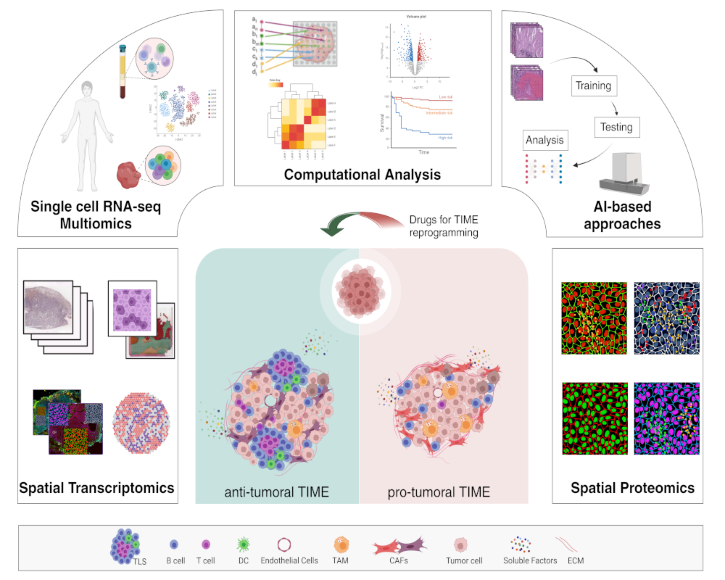Journal of Experimental & Clinical Cancer Research is calling for submissions to our Collection on “Charting the Tumor Immune Microenvironment: Advances in Spatial Profiling and Novel Therapeutic Avenues”. In this Collection, we aim to offer a comprehensive overview of the current landscape of the Tumor Immune Microenvironment (TIME) properties, considering cellular and non-cellular components, emphasizing innovative technologic tools to clinically translate recent research breakthroughs (1). Cancer-intrinsic factors such as genetic alterations, a broad range of cellular TIME components including cancer-associated fibroblasts, endothelial cells, and immune cells, along with extracellular matrix and soluble factors like cytokines, interact with each other to either suppress or favor anti-tumor immunity (2-7). Unveiling this reciprocal dialogue, the dynamics, and the spatial positioning of TIME components is fundamental to improving patient clinical outcomes and identifying the molecular mechanisms underlying TIME-mediated immunomodulation and utilize TIME landscape for clinical applications. The integration of high-resolution technologies and computational developments is significantly accelerating the addressing of these fundamental issues. This may open up novel translational and clinical opportunities for the development of more effective therapeutic combinations with the potential to significantly improve and broaden the response to therapy in solid tumors.
References:
1. Toninelli M, Rossetti G, Pagani M. Charting the tumor microenvironment with spatial profiling technologies. Trends Cancer. 2023 Dec;9(12):1085-1096
2. Di Modugno F, Di Carlo A, Spada S, Palermo B, D'Ambrosio L, D'Andrea D, Morello G, Belmonte B, Sperduti I, Balzano V, Gallo E, Melchionna R, Panetta M, Campo G, De Nicola F, Goeman F, Antoniani B, Carpano S, Frigè G, Warren S, Gallina F, Lambrechts D, Xiong J, Vincent BG, Wheeler N, Bortone DS, Cappuzzo F, Facciolo F, Tripodo C, Visca P, Nisticò P. Tumoral and stromal hMENA isoforms impact tertiary lymphoid structure localization in lung cancer and predict immune checkpoint blockade response in patients with cancer. EBioMedicine. 2024 Mar;101:105003
3. Ramachandran M, Vaccaro A, van de Walle T, Georganaki M, Lugano R, Vemuri K, Kourougkiaouri D, Vazaios K, Hedlund M, Tsaridou G, Uhrbom L, Pietilä I, Martikainen M, van Hooren L, Olsson Bontell T, Jakola AS, Yu D, Westermark B, Essand M, Dimberg A. Tailoring vascular phenotype through AAV therapy promotes anti-tumor immunity in glioma. Cancer Cell. 2023 Jun 12;41(6):1134-1151
4. Enfield KSS, Colliver E, Lee C, Magness A, Moore DA, Sivakumar M, Grigoriadis K, Pich O, Karasaki T, Hobson PS, Levi D, Veeriah S, Puttick C, Nye EL, Green M, Dijkstra KK, Shimato M, Akarca AU, Marafioti T, Salgado R, Hackshaw A; TRACERx consortium; Jamal-Hanjani M, van Maldegem F, McGranahan N, Glass B, Pulaski H, Walk E, Reading JL, Quezada SA, Hiley CT, Downward J, Sahai E, Swanton C, Angelova M. Spatial Architecture of Myeloid and T Cells Orchestrates Immune Evasion and Clinical Outcome in Lung Cancer. Cancer Discov. 2024 Jun 3;14(6):1018-1047
5. Meylan M, Petitprez F, Becht E, Bougoüin A, Pupier G, Calvez A, Giglioli I, Verkarre V, Lacroix G, Verneau J, Sun CM, Laurent-Puig P, Vano YA, Elaïdi R, Méjean A, Sanchez-Salas R, Barret E, Cathelineau X, Oudard S, Reynaud CA, de Reyniès A, Sautès-Fridman C, Fridman WH. Tertiary lymphoid structures generate and propagate anti-tumor antibody-producing plasma cells in renal cell cancer. Immunity. 2022 Mar 8;55(3):527-541
6. Ruffin AT, Li H, Vujanovic L, Zandberg DP, Ferris RL, Bruno TC. Improving head and neck cancer therapies by immunomodulation of the tumour microenvironment. Nat Rev Cancer. 2023 Mar;23(3):173-188
7. Croizer H, Mhaidly R, Kieffer Y, Gentric G, Djerroudi L, Leclere R, Pelon F, Robley C, Bohec M, Meng A, Meseure D, Romano E, Baulande S, Peltier A, Vincent-Salomon A, Mechta-Grigoriou F. Deciphering the spatial landscape and plasticity of immunosuppressive fibroblasts in breast cancer. Nat Commun. 2024 Apr 1;15(1):2806
Keywords: Tumor Immune Microenvironment, Immune cells, Tertiary Lymphoid Structures, Cancer Associated Fibroblasts, Endothelial Cells, Spatial Transcriptomics, Cytokines, Solid Tumors
Image credit: © Nicla Porciello

